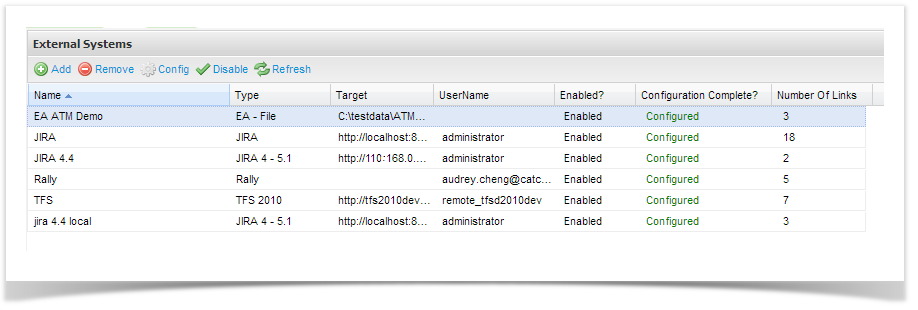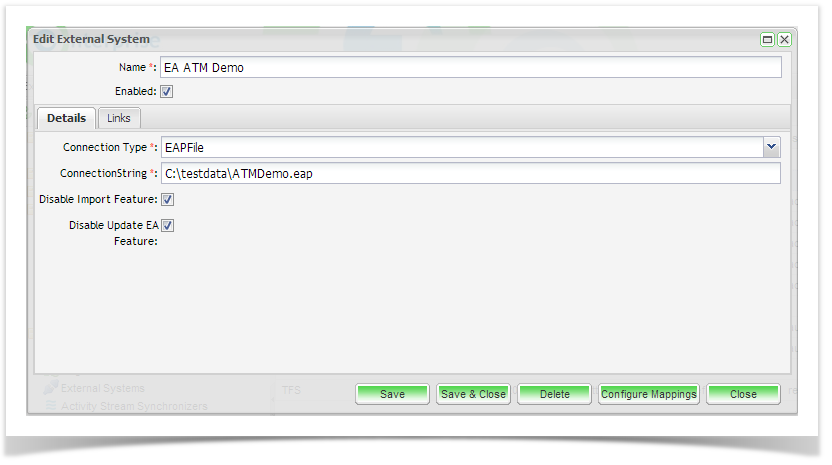Connecting to Enterprise Architect
Enterprise Tester supports importing Requirements and Use Cases from Enterprise Architect (EA). This help topic supports configuring a connection for requirements and use case import from Enterprise Architect. Before you begin, please read the help topic External Systems (Integration). This topic will provide the fundamental of setting up and external system.
Supported EA Databases
Many organizations use a single shared repository, which can connect to other repositories, and is managed at an organizational level.
Actual links between project requirements and test cases are then created in the projects and use these EA connections. As part of the set up for a connection you need to configure the mapping of pick list values and this can be done at the connection level while saves you time as you will not need to configure it for individual links.
Enterprise Tester currently supports connections to the following repositories:
Oracle
SQL Server
EAP files
PostgreSQL
MySQL
You can have as many connections as you require within your organization.
Default Accounts
Enterprise Tester directly connects to the EA Repository (database), so the account Enterprise Tester runs under must be given appropriate permissions, here is the list of default accounts per operating system /IIS version:
IIS Version / Operation System | Default Account |
IIS5.1 - Windows XP | ASPNET |
IIS 6 - Windows Server 2003 | NetworkService |
IIS 7 - WindowsVista/ Windows Server 2008 | NetworkService |
IIS 7.5 - Windows Server 2008r2 / Windows 7 | NetworkService or the AppPoolIdentity (normally IIS APPPOOL\DefaultAppPool - see here for more details : http://learn.iis.net/page.aspx/624/application-pool-identities/) From V4.1, Network Service will always be the default account in IIS 7.5. |
Database Connections
Database repository connections (Oracle, SQLServer, MySQL, & PostgreSQL) will generally "just work" when using an embedded username/password in the connection string.
If you wish to use a connection string that uses integrated authentication, then in that case the user the Enterprise Tester we application runs under i.e. NetworkService, must be given permission to read/write data to the target database.
SQL Server
For SQL Server - see this article:
http://msdn.microsoft.com/en-us/library/ff647402.aspx
In the SQL Server section, the article details how to setup access to either a local or remote SQL server database using integration authentication with the NetworkService etc. account.
Oracle
For Oracle, you can use a "trusted connection" by specifying the OSAuthent=1 parameter in the connection string, see here for examples of connection strings:
http://connectionstringexamples.com/staticpages/index.php?page=20080710090445267
Add access for an external identified user to Oracle is out of scope for this documentation, but a basic guide can be found here:
http://www.databasedesign-resource.com/users-in-oracle.html
PostgreSQL
Support for trusted connections are provided by using the "Integrated Security=true" connection string, for connection string examples see here (the Npgsql section):
http://www.connectionstrings.com/postgre-sql
Details of authentication methods for PostgreSQL is documented here:
http://www.postgresql.org/docs/8.3/static/auth-methods.html
MySQL
Support for trusted connections may not be provided for MySQL when connecting from .Net.
Examples of connection strings can be found here:
http://www.connectionstrings.com/mysql
See the "MySQL Connector/Net" section for details.
Secured Repositories
When using the "Catch API" plug-in, the database tables containing Element information are accessed directly, the secured repository security model is by-passed - so there is no need to provide a username/password - however if one is supplied then it will just be ignored.
Creating Enterprise Architect Connections
To create an EA connection navigate to the Admin Tab on the ET navigator. Expand Extension and double click on External Systems.
From the ‘External Systems’ screen, you can set up your Enterprise Architect connection. If connections have already been configured for other EA repositories or other external systems, they will be listed here.
Click add from the tool bar to bring up the ‘Add External System’ dialog box.
Enter a name for your external system connection and select your external system type. Click on Save.
On the edit External System screen enter in the following details:
Connection Type - select the EA repository type from the drop down list.
Connection String - the connection string details are dependent on the connection type (see details below)
Oracle Connections
This is the connection string required to access the Oracle database:
DBType=3;Connect=Provider=OraOLEDB.Oracle.1;Password=password;Persist Security Info=True;User ID=SYSTEM;Data Source=ORA11TST
You can copy this from the EA connect dialog of an existing connection that has been set up in Enterprise Architect.
SQL Server Connections
This is the connection string required to access the SQL database:
DBType=1;Connect=Provider=SQLOLEDB.1;Integrated Security=SSPI;Persist Security Info=False;Initial Catalog=EaTestRepository;Data Source=HPQC90TEST
You can copy this from the EA connect dialog of an existing connection that has been set up in Enterprise Architect.
EAP File Connections
The file path to the required EAP file e.g. C:\Testfiles\Demo.EAP. This pathway must be on the host and not your local drive or on a network drive that is accessible by the server Enterprise Tester is installed on.
Disabling the Import and Update Features
Enterprise Tester provides the ability to created and update requirements and test cases by importing Elements from EA and to update requirements in EA with the information stored in Enterprise Tester.
Enterprise tester provides the ability to disable these features. This feature can be useful if you would like to enable the features for an import or update and then disable them after the process is complete. As the Update feature will update all values in EA regardless of which system holds the latest change, this feature can give you some control over when this functionality is accessible. When disabled the functions are no longer available on the project link screen.
Once you have completed the configuration details, Enterprise Tester will then test the connection and if successful it will be saved.
Enterprise Architect and Enterprise Tester Field Mappings
Once the EA connection is saved the field mapping will need to be set up before you can import or synchronize between EA and Enterprise Tester. You can configure this at the organisational level so that you don't need to complete the mapping for each project. However, you will still need to create the project links for each project. From the EA External System screen, click on the Configure Mappings button on the bottom right corner.
There are two sets of mapping to be configured:
- Enterprise Architect to Enterprise Tester
- Enterprise Tester to Enterprise Architect
To do this:
- Click on Configure Connection - the Map Fields screen will display:
- Select the mappings for each value. Matching values will automatically be mapped.
- Click on ‘Save’ - connection is ready to be used.
See further sections on how to Import/ Export requirements and use cases with Enterprise Architect.


